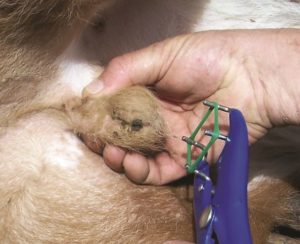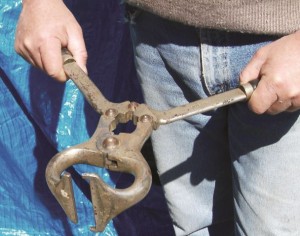What Is Young Female Beef Called What Is Castrated Beef Called
Castration is 'removal of the testicles' in very young male cattle. Notwithstanding some of the techniques used to 'desexualize' bull calves in Commonwealth of australia do not involve actual removal of the testicles.
Castration is carried out for the post-obit reasons:
- Prevention of undesirable balderdash calves from convenance. This enables mating of bulls only with desirable traits.
- Behavioural control. Castrated male cattle (steers) are generally less ambitious and easier to handle, are less likely to fight causing injury to other animals, and are less likely to harm fences.
- The secondary sex characteristics of bulls tend to make bull meat tougher and less attractive to consumers, peculiarly for the higher priced cuts.
The disadvantages of castration are pocket-size in comparing to the advantages gained. Removal of the testicles earlier puberty will reduce the growth charge per unit of the calf. This is because the testicles produce hormones likewise equally spermatozoa. The major hormone produced by the testicles is testosterone, more ordinarily referred to as male hormone. Testosterone has an anabolic action – information technology promotes muscle growth.
Castration should exist carried out on balderdash calves when they are very young, and certainly before half-dozen months of age. On larger properties with large numbers of breeding females this may exist difficult to achieve, peculiarly if calves are born at the start of the wet season (as recommended) or just after the last muster the previous year.
Methods of castration
With all methods of castration constructive restraint (i.e. calf cradle) is essential for the welfare of the calf and the operator. Whether performing surgical or non surgical castration it is important to disinfect equipment in an antiseptic solution, between animals, and have a separate bucket of antiseptic for washing hands. Data about options for pain relief during castration tin exist establish at Pain relief medication for beef cattle.
Surgical
This is the most commonly used method of castration in Australia.
An incision is made at the bottom of the scrotum using a scalpel bract to expose the testicle. In some cases the testicles proper may still be hidden behind a thick whitish membrane – the tunica vaginalis. If this is the case information technology volition exist necessary to brand an incision in the tunica to completely expose the testicle. A deep initial incision ensures the testicle is exposed immediately. The attached ligaments and vas deferens (sperm cord) can be separated from the testicle with the fingers and/or blade.
The testicle tin can exist removed by pulling on the exposed testicle (this is less suitable for older calves) or by rubbing the sharp blade sideways on the exposed string to scrape the claret vessels. Do not make a make clean precipitous incision of the cord equally this may lead to excessive haemorrhage. The almost desirable method is to remove the exposed testicle using triple crush emasculators which crushes and cuts the blood vessels and hence minimises bleeding. Emasculators are the preferred selection for older calves and for castrations washed in hotter weather.
Expert hygiene is essential when castrating. Information technology is preferable that the scalpel and emasculators are soaked in disinfectant between operations and that the disinfectant is inverse afterwards every twenty animals. Poor hygiene may atomic number 82 to infection which delays healing and may set back growth. Wing command should exist considered at certain times of the year. Calves should be vaccinated against tetanus.
Elastrator rings
 An elastrator ring placed above the neck of the scrotum will cut off all blood vessels and after a period of time (ordinarily 3 to six weeks) lead to that function of the scrotum and its contents (mainly the testicles) dropping off.
An elastrator ring placed above the neck of the scrotum will cut off all blood vessels and after a period of time (ordinarily 3 to six weeks) lead to that function of the scrotum and its contents (mainly the testicles) dropping off.
Some cattle breeders adopt this method because it is a non-invasive method of castration. Another advantage of elastrator rings is that trivial or (usually) no bleeding occurs. There is no scientific show that use of elastrator rings reduces contagion by tetanus or other organisms.
Because the elastrator rings are designed and made for use on sheep, they are generally only able to be used on smaller calves. It is difficult to place the ring higher up the testicles of larger animals. The Australian Code of Do for the Welfare of Animals states that elastrator rings are only suitable for calves nether 2 weeks of age.
Burdizzo (Anemic castration pincers)
 Burdizzo is the trade proper noun for an Italian made bloodless castration pincers. The master of operation is like to that of the elastrator ring. If used correctly the blood vessels and spermatic string are meant to be irreparably crushed, thus stopping blood supply preventing testicle growth and function. Within six weeks atrophy of the testicles should be complete.
Burdizzo is the trade proper noun for an Italian made bloodless castration pincers. The master of operation is like to that of the elastrator ring. If used correctly the blood vessels and spermatic string are meant to be irreparably crushed, thus stopping blood supply preventing testicle growth and function. Within six weeks atrophy of the testicles should be complete.
This technique is successful when used past experienced operators. Due to risk of failure it is not recommended for utilize by inexperienced operators. There appears to be less hurting and there is reduced risk of infection as the wound is non open.
The Burdizzo has the advantage of elastrator rings in that it is non-invasive and causes no bleeding. Different elastrator rings it can exist used on older animals. Notwithstanding the Australian Code of Do for the Welfare of Animals states that this method should only be used on calves under six months of historic period if done without anaesthetic.
This information is simply intended every bit a brief overview of castration methods. To learn more about castration and right castration technique recommended reading is A guide to best practice husbandry in beef cattle: branding, castrating and dehorning (PDF, 3MB), a free Meat & Livestock Australia publication.
Dennis Boothby, formerly Queensland Government.
Source: https://futurebeef.com.au/resources/castration/
0 Response to "What Is Young Female Beef Called What Is Castrated Beef Called"
Post a Comment